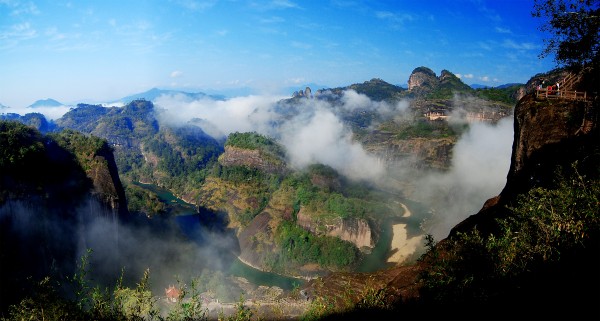Geography and History


Natural Conditions and Geography
Fujian Province is called Min for short. Situated on the southeast coast of the Chinese mainland, the province faces Taiwan Straits to the east, and borders Jiangxi Province to the west, Guangdong Province to the south, and Zhejiang Province to the north.
An early record of Fujian can be found in The Classic of Mountains and Seas, an ancient compilation of China’s mythic geography and myth, which states that Fujian sits in the sea. Fujian covers a land area of 124,000 sq. km., and a sea area of 136,000 sq. km. As one of the major marine economies in China, it boasts the second longest coastline that runs as long as 3,752 km, with a straight length of 535 km and a curving rate of 1:7.01, ranking first in the country. There are 2,214 islands in the province, and the Pingtan Island is the biggest. The total number of harbors amounts to 125, among which are 22 deepwater harbors and 7 natural harbors that allow the free access of 50,000-tonnage ships, taking up 1/6 of the national figure. The coastline resources provide us with the capacity to build 80 berths suitable for accommodating 200,000-tonnage and above ships. The sea area good for tidal power generation totals 3,000 sq. km. And the exploitable installed capacity of tidal energy reaches 10.33 million kilowatts, accounting for 49.2% of the national total and ranking first in China.
Located in the subtropical oceanic monsoon climate area, Fujian is lucky enough to have the mountain ranges in the northwest to ward off the cold winds in winter, and to have the sea breeze coming from the southeast to regulate the climate. Therefore, most part of the province suffer less the freezing cold in winter and the sweltering heat in summer, with the largest amount of rainfall in the country.
Endowed with favorable natural conditions, Fujian is one of the four major forest regions in China, and enjoys the fame of “Green treasure house in the south”. The woodland accounts for 65.95% of the total area with stocking volume standing at 608 million cubic meters, and bamboo forest 993,100 hectares, all ranking first in China. The province falls into the front ranks in biodiversity in the country, and witnesses the survival of many rare plants of the cretaceous period and the Tertiary period, such as gingkgo, pseudolarix and podocarpus macrophyllus.
Situated in one of the major metallogenic belts around the Pacific Rim, Fujian is a region rich in natural resources. By the end of 2015, 118 solid mineral deposits are registered in the records, of which the deposits of 27 types rank among the top 5 nationwide. The Zijinshan Gold Mine was rated by China Gold Association as the biggest gold mine across the country.
Boasting spectacular mountains and vast oceans, Fujian has long been renowned as the “Mountainous State in the southeast”, with Wuyi Mountains in the north, Qingyuan Mountain in the south, Taimu Mountain in the east, Guanzhai Mountain in the east and Daiyun Mountain in the midst. Each of these mountain ranges presents a picturesque landscape. Moreover, the whole province abounds with rivers and lakes, with Min River, Jiulong River, Jin River, Ting River and Jiaoxi River constituting the five major river systems in Fujian. And the numerous beautiful lakes, such as Taining Golden Lake, Xiamen Yundang Lake and Gutian Cuiping Lake shine in the land of Fujian like bright pearls.


Historical Evolution
As early as 5,000 years ago, the indigenous inhabitants created the world-renowned Tanshishan culture. In the Western Zhou Dynasty, seven tribes appeared and flourished in this land, called Seven Min (seven administrative divisions). In the mid Warring States period, after the Yue State collapsed, some ethnic Yue people unwilling to submit themselves to the rule of Chu State emigrated southward to the land of Min and merged into the indigenous Min people to form the Ethnic Minyue. At the end of Warring States period, Mr. Wuzhu governed the land of Fujian and the neighboring areas of South Zhejiang, East Jiangxi and West Guangdong, and claimed himself the King of Minyue State. He established the capital in Ye (now Fuzhou city), thereafter the regime came into being in Fujian. In the Qin Dynasty, Minzhong Prefecture was set up in this area, with Fujian under its jurisdiction. Thence, Fujian started to appear in the map of China. Emperor Gaozu of the Han Dynasty entitled Wuzhu as King of Minyue State. In 260, Jian’an County (now Jian’ou City) was established during Yong’an reign of the Three Kingdoms. In 733, an official post of Fujian military commissioner was set up during the Kaiyuan Reign of the Tang Dynasty (618-907). From then on, the area has been known as Fujian. During the Southern Song Dynasty (1127-1279), Fujian was composed of one Fu, five Zhous, and two Juns. For that reason, the province is also known as Eight Min (eight administrative divisions). In the Yuan Dynasty, province was set up in the area. In the Ming Dynasty, Fujian administrative commissioner's office governs eight Fus, one Zhou and sixty counties. The Qing Dynasty inherits the administrative division system from the Ming Dynasty. While in 1684, the 23rd year of the reign of Emperor Kangxi, Taiwan Fu (municipality) was established under the jurisdiction of Fujian Province. In 1886, the 12th year during the reign of Emperor Guangxu, Taiwan was singled out from Fujian and upgraded to a province.
Fujian was an important birthplace of China’s marine culture and a major commercial center in history. Quanzhou City, a starting point of the ancient Maritime Silk Road, witnessed the flourishing international trade of China and the bustling scenarios of foreign merchants coming in flocks. And Mawei Port, the cradle of modern Chinese shipbuilding industry and a famous naval base, had cultivated numerous high-caliber talents.
Fujian is also the birthplace of many regional cultures, such as Minnan culture (Southern Fujian culture), Hakka culture, Mazu culture, shipyard culture, Zhu Xi culture, Ethnic SHE culture and Revolutionary culture. The province houses a number of world heritage sites. Wuyi Mountains (a world cultural and natural heritage site), Fujian Tulou (the earthen buildings, a world cultural heritage site), Taining Danxia landscape (a world natural heritage site), and two Global Geoparks (Taining and Ningde), just to name a few.
It’s here in Fujian that many outstanding talents and historical figures were brought up, such as Wang Shenzhi, Zhu Xi, Song Ci, Zheng Chenggong, Lin Zexu, Yan Fu, Lin Shu, Chen Jiageng, Bing Xin, Hou Debang, and Chen Jingrun.
Population & Administrative Divisions
Fujian has a permanent population of over 38 million, with all the 56 ethnic groups scattering across the province. According to the 6th national census, the population of ethnic groups in Fujian amounts to 796,900, among whom 365,500 are ethnic SHE, accounting for 51.6% of the total in China. We have now 19 ethnic townships, one provincial level ethnic economic development zone and 576 ethnic villages. Under the jurisdiction of Fujian are now nine multi-district cities (Fuzhou, Xiamen, Zhangzhou, Quanzhou, Sanming, Putian, Nanping, Longyan, and Ningde) and Pingtan Comprehensive Pilot Zone. There are 85 counties (or cities at county level) and districts in total.


